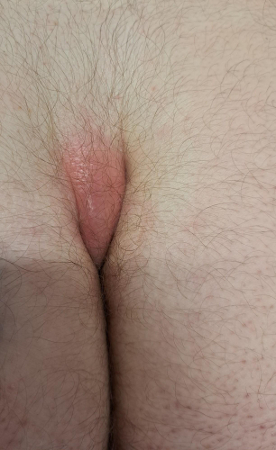History and exam
Key diagnostic factors
common
sacrococcygeal discharge
Patients may report an offensive discharge from the natal cleft, and staining of underwear.
sacrococcygeal pain and swelling
Patients usually report discomfort or pain associated with the pilonidal sinus, particularly when sitting.
[Figure caption and citation for the preceding image starts]: Acute sacrococcygeal pilonidal abscessWalker H, et al. BMJ 2023; 382: e071511; used with permission [Citation ends].
sacrococcygeal sinus tracts
Patients will have one or several sinus tracts that can be seen at or around the midline of the natal cleft.
Other diagnostic factors
common
at risk demographic (male, age 15 to 45 years, hirsutism)
Pilonidal disease is more common in males (~80%), most likely due to greater hirsuteness in men compared with women.[1]
Pilonidal sinus is uncommon before puberty and beyond 45 years of age with a mean age at presentation of 21 years in males and 19 years in females.[1]
Patients with significant hair within the natal cleft are much more likely to have pilonidal disease compared with those with no hair in the natal cleft.[12]
modifiable risk factors (prolonged sitting, perineal hygiene)
history of prior rupture of fluid into natal cleft
Patients often report a history of a previously treated abscess in the natal cleft, or one that ruptured spontaneously.
skin maceration
Maceration of the skin in the natal cleft is common due to chronic irritation caused by the sinus discharge.
acutely increased natal cleft pain and swelling
Where superinfection has occurred, an abscess may be present.
uncommon
fever
Where superinfection has occurred, an abscess may be present.
Risk factors
strong
male sex
Pilonidal disease is more common in males. In one meta-analysis of surgical treatments for pilonidal sinus, over 80% of participants were male.[1] This is most likely due to greater hirsuteness in men compared with women.
age 15 to 45 years
prolonged sitting
Patients with pilonidal disease are more likely to spend more time sitting per day. In one prospective case control study, people who sat for more than six hours per day were four times more likely to have pilonidal disease, compared with people who sat down for less than six hours per day.[12]
hirsutism
Patients with significant hair within the natal cleft are nine times more likely to have pilonidal disease, compared with patients with no hair in the natal cleft.[12]
frequency of bathing
Individuals taking two or fewer baths or showers per week are over six times more likely to have pilonidal disease, compared with individuals taking three more baths or showers per week.[12]
weak
overweight
Body mass index (BMI) is elevated in patients with pilonidal disease. Compared with patients with a normal weight (BMI <25 kg/m²), overweight patients are 1.56 times more likely to have pilonidal disease.[12]
family history of pilonidal disease
Evidence for family history as a risk factor for pilonidal disease is mixed. One study found a family history of pilonidal disease in 38% of patients presenting with pilonidal disease.[2] Another reported a higher frequency of family history in patients compared with controls.[3] A more recent study demonstrated a slightly higher incidence of family history in patients with pilonidal disease (16.7% vs 14.6%), but this did not reach statistical significance.[12]
Use of this content is subject to our disclaimer